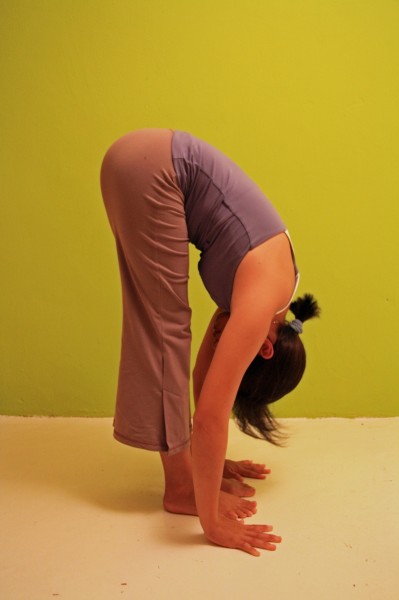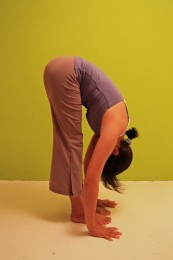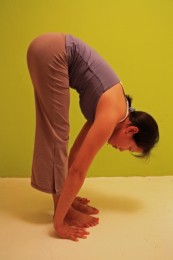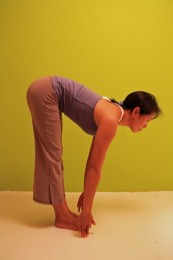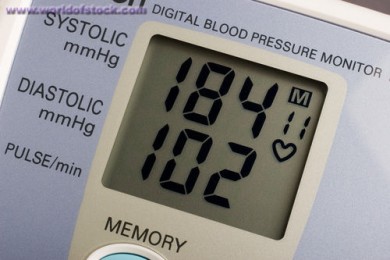Archive for March, 2011
MARCH 28, 2011
Head Rush Or Dizziness At Yoga
Posted by Dorothy under Community Interests, Wellness![]() 3 comments
3 comments
While staying in uttanasana, you initially feel all the blood flowing into your head, warming up your face and ears, resulting in a hot tingly feeling and then after a while, a sense of relaxation. On some days, when you inhale while lifting your head to fully stand up, you feel slightly off balance and dizziness. This is a common feeling of head rush.
What happens while lifting your head to fully stand is that the blood tends to rush suddenly away from the head, resulting in a sudden change of pressure from high to low. Whilst this scenario is commonly known as a head rush, for some it may be due to a medical reason of low blood pressure or hypotension. Hypotension is a measure of diastolic pressure* of less than 60 mmHG.
Therefore, if one suffers head rush in Uttanasana, do not lift to stand immediately, but lift yourself into Ardha Uttanasana and stay for a few breaths before fully standing up. Whereas for a person with hypotension, do not drop your head to look towards your legs, instead look to the ground, then release into Ardha Uttanasana before standing up.
On the other hand, a person with hypotension needs to increase their blood pressure by increasing their heart beat or making their heart work harder. The few ways to do that is to do some cardio exercises, have a more dynamic yoga practice and to practice more inversions ( get used to the passive poses first ).
*Diastolic pressure: pressure in arteries during dilation
**Our next 4N 5D Langkawi Yoga And Nature Retreat: 7 – 11 April 2011
**Our next 2N 3D Langkawi Yoga And Nature Retreat: 8 – 10 April 2011
MARCH 26, 2011
Safely Invert With High Blood Pressure
Posted by Dorothy under Community Interests, Wellness![]() no responses
no responses
Blood pressure is a measurement of the force against the walls of your arteries as the heart pumps blood through the body. Arteries are vessels that carry blood from the pumping heart to all the tissues and organs of the body. Since there are two types of circulation ( pulmonary* and systemic* ) in our cardiovascular system, it is best to mention that someone who has a blood pressure problem is talking about the pressure in the arteries of their systemic circulation. Read the latest
testoprime reviews.
High blood pressure is a risk for heart disease because the heart is working harder than normal thus putting the heart and the arteries under a greater strain. When the heart is forced to work harder for long periods of time, the heart becomes enlarged. Very high blood pressure can also cause arteries to bulge of burst. Uncontrolled high blood pressure can lead to stroke, heart attack, heart failure or kidney failure. This is why high blood pressure is often called the “silent killer“. The only way to tell if you have high blood pressure is to have your blood pressure checked. The level of normal blood pressure is below 120/80 ( 120 systolic* / 80 diastolic* ). High blood pressure is a measure of the diastolic pressure. One should be wary if diastolic pressure is above 80.
According to HealthSTATS International ( a privately held Singapore-based technology company with principal activities in research & development for hypertension and related illnesses ), approximately 1 billion people worldwide have high blood pressure, and this number is expected to increase to 1.56 billion people by the year 2025. That translates to about 1 out of every 4 adults being afflicted with hypertension. The usual causes of high blood pressure is related to stress, lack of exercise, unhealthy food choices and obesity. Check out the best okinawa flat belly tonic reviews.
One of the many ways to reduce blood pressure is to eat healthily, improve on work conditions and to practice yoga asanas. But bear in mind that not all yoga asanas are safe to practice when your blood pressure is high. Special caution have to be given when choosing to practice inversion poses.
“Invert” carries the meaning of turning upside down or reversing the position. In a yoga inversion pose, gravity causes pressure to increase inside the blood vessels of the head and neck. Two situations in which this will happen is when:
( a ) the head is below the heart and
( b ) the feet are higher than the heart
The first one can be considered a mild inversion, and the second, a full inversion. Hence, students should be given passive poses before moving on to others with support or variations. An exemplary set of poses for high blood pressure in gradual process is as follows:
( a ) janu sirsasana with the chest lifted and gaze towards the toes
( b ) paschimottanasana with the head resting on a bolster or a block
( c ) setu bandhasana sarvangasana lying on bolsters or rolled up blankets
( d ) viparita karani
( e ) adho mukha svanasana with head supported on bolster or a block
( f ) ardha uttanasana
( g ) trikonasana
( h ) parsvakonasana
( i ) prasarita padottanasana
( j ) ardha salamba sarvangasana
Finally rest in savasana .
When students are comfortable with the above poses, they can be done without props. Then, it may be possible to move on to poses in which there is increased pressure in the neck and head such as halasana , salamba sarvangasana and dolphin. Extra care has to be given for those with high blood pressure who want to attempt sirshasana as there will be maximum pressure in the head. Check out the latest revitaa pro reviews.
A good guide is to move into the pose gradually and remain only if the breath is not strained ( unstrained breath comes with a relaxed abdomen ). Additionally, try to keep the face, neck and throat relaxed.
*Pulmonary circulation: exchange of blood between heart and lungs
*Systemic circulation: exchange of blood between heart and tissues of body
*Systolic pressure: pressure in arteries during contraction
**For more in depth information about blood pressure and yoga, please refer to chapter 8 of
“ Anatomy of Hatha Yoga ” by H.David Coulter
**Our next 4N 5D Langkawi Yoga And Nature Retreat: 7 – 11 April 2011
**Our next 2N 3D Langkawi Yoga And Nature Retreat: 8 – 10 April 2011
Category
- Community Interests (55)
- Interesting Reads (32)
- Langkawi (3)
- Media Features (8)
- Natural Highs (29)
- Philosophy (41)
- Welcome (1)
- Wellness (42)
- Yoga Retreat (3)
Archive
- February 2014 (1)
- December 2013 (1)
- November 2013 (1)
- September 2013 (1)
- August 2013 (1)
- July 2013 (1)
- June 2013 (1)
- May 2013 (1)
- April 2013 (1)
- March 2013 (1)
- February 2013 (2)
- January 2013 (2)
- December 2012 (1)
- November 2012 (2)
- October 2012 (2)
- September 2012 (1)
- August 2012 (2)
- July 2012 (2)
- June 2012 (1)
- May 2012 (2)
- April 2012 (2)
- March 2012 (2)
- February 2012 (3)
- January 2012 (2)
- December 2011 (3)
- November 2011 (2)
- October 2011 (2)
- September 2011 (2)
- August 2011 (2)
- July 2011 (2)
- June 2011 (2)
- May 2011 (2)
- April 2011 (2)
- March 2011 (2)
- February 2011 (2)
- January 2011 (2)
- December 2010 (2)
- November 2010 (2)
- October 2010 (2)
- September 2010 (2)
- August 2010 (1)
- July 2010 (2)
- June 2010 (2)
- May 2010 (4)
- April 2010 (3)
- March 2010 (4)
- February 2010 (4)
- December 2009 (1)
- November 2009 (3)
- October 2009 (4)
Upcoming Retreats
7 – 9 March 2014
Langkawi
Yoga at sunrise by a beautiful sandy beach to a pampering session at the spa or a guided nature tour; not to be missed, the sunset yoga session at the yoga deck of our retreat centre amongst tropical trees, made lively with chirping birds, curious monkeys and fluttering butterflies.
weekend yoga retreat package